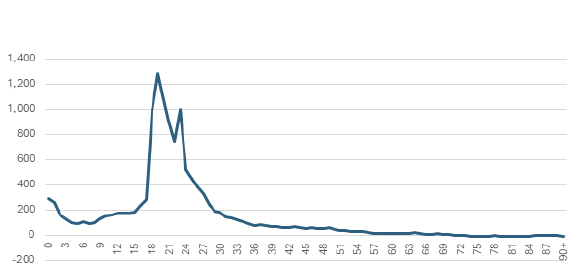Migration - Meeting Scotland's Needs
An overview of the vision, values, and policy proposals underpinning the Scottish Government's strategic approach to migration policy.
The Economic Benefits of Migration to Scotland
17. The majority of research finds evidence of a positive impact of migration on host countries.
18. Migrants who find work in Scotland directly contribute to economic growth by increasing the supply of labour and boosting the economy’s productive capacity, leading to higher levels of economic activity and employment[2]. Migrants help to expand our workforce but also contribute to the demand for goods and services in the economy. In-migration boosts GDP.
19. Scotland’s distinct demographic challenge means that the economic role of migration is particularly important. Scotland’s history of outmigration and the structural legacy of that migration history which has contributed to an ageing, and potentially shrinking, population has implications for fiscal sustainability, public service provision, and economic growth.
20. The size and total share of the working age population, those individuals aged 16 to 64, is very important for the economy and public services. These individuals are more likely to be working and are likely to be generating the highest tax receipts. In their Fiscal Sustainability Report[3] the Scottish Fiscal Commission projected that Scotland’s long term GDP growth rate will be consistently below that of the UK, with the difference being driven by Scotland's more pronounced reduction in labour supply and demographic change.
21. From 2025-75, Scotland’s working age population is projected to fall by 14.7%, compared with a 0.5% increase in the working population of the UK[4].
22. Higher net migration in the future could help offset the challenges which will arise from an ageing and shrinking population in Scotland by helping to boost the size and proportion of the working age population. As outlined above, migrants are generally younger than the general population and are more likely to be of working age. Positive net migration therefore increases the size of the working-age population, which is crucial for economic growth as well as fiscal sustainability.

Source: NRS International Migration Statistics
23. Migration is also associated with increased business activity, productivity, and innovation. Evidence shows that migrants are more likely to establish new businesses, generating employment opportunities. Research from the Federation of Small Businesses found that one in ten SMEs in Scotland are immigrant led[5].
24. Work undertaken on behalf of the UK Migration Advisory Committee found that a 1% increase in the migrant share of the workforce is associated with a productivity improvement of between 1.2% and 3% in the UK[6]. A summary of the available evidence by the Bank of England also suggests migration by EU workers boosts long-run GDP per capita, through an increase in patenting and the breadth of skills in the workforce. The summary also found strong links between migration and increasing trade[7].
25. Migrants who stay in Scotland after studying at a Scottish University may be even more likely to innovate, as they will benefit from having received world class education and skills training. Research[8] for the US has found that a 1% increase in immigrant college graduates can increase patents per capita by 9-18%.
26. Research has shown that migrants contribute more to government revenue through taxes than they receive in public services. Work by Oxford Economics concluded that both EEA and non-EEA migrants are expected to make a significant positive contribution to the UK public finances, with the future net contribution of 2016 arrivals to the UK estimated at £26.9 billion, or 1.3% of GDP[9]. This is approximately equivalent to the additional revenue from adding five pence to the rate of each UK income tax band in one year.
27. Moreover, the office for budgetary responsibility (OBR) generally forecast that increased net migration leads to lower deficits and debt, even after adjusting for public spending. This is because incoming migrants are more likely to be of working age than the population in general and are therefore more likely to be working and contributing to public finances.
28. Migrants who find work in Scotland are particularly important to Scotland’s seasonal industries and rural communities. Prior to the pandemic, 8.3% of Scotland’s overall employment were non-UK migrants in 2019, with an even higher share in sectors such as Food & Drink and Tourism, where it was 15% and 16% respectively.
Contact
Email: migration@gov.scot
There is a problem
Thanks for your feedback